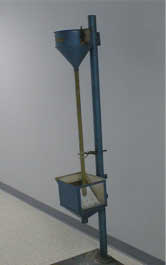Abrasion Testing
Accelerated Life Testing
Chemistry Laboratory
Computer Modeling
Salt Spray Testing
Density
Electrical Properties
Electron Microscopy
Experimental Foundry
Failure Analysis
Hardness Laboratory
Heat Treatment Studies
Light Microscopy
Lubrication Testing
Machine Shop
Materials Databases
Mechanical Testing
Metallography
Paint & Coatings
Product Testing
Rolling Mill
Thermal Testing
Abrasion Testing
Moving samples can be tested in contact with various abrasives at a wide array of speeds, orientations, and contact pressures.

Falling Sand Tester
As the name indicates, the falling sand tester measures the abrasion resistance of paint or other coatings to falling sand. The work is performed according to ASTM D 968. Quartz sand with a specific grain size is poured through a funnel and guide tube to impinge on a test plate. Typically this test is used to determine the abrasion resistance of a painted surface. Because it is essentially a MOHs test, it can be adapted to determine relative wear resistance of many materials by varying the size and hardness of the abrasive used. For instance, wear resistance of polymer composite panels can be evaluated using the falling sand method.
Taber Abraser
The Taber Abaser measures the resistance of organic coatings applied to a plane, rigid surface such as a metal panel. The surface of the organic coating is abraded by rotating the panel under weighted abrasive wheels. This procedure is described in ASTM D 4060. Commonly used for determination of abrasion resistance of painted surfaces, this procedure has been used on polymer composites used by the petroleum industry and the space industry. Abrasive wheels range from very soft rubber matrix with silica abrasives to very hard ceramic abrasive wheels.
Custom Abrasion Testing
Touchstone can provide custom abrasion testing upon request. Moving samples can be tested in contact with various abrasives at a wide array of speeds, orientations, and contact pressures.

